Martin Edwards's Blog, page 22
August 7, 2024
Before the Devil Knows You're Dead - 2007 film review

Before the Devil Knows You're Dead was the last film directed by Sidney Lumet, but there's absolutely no sense of lack of energy about a movie that's unpredictable and gripping from start to finish. It's a thriller about a robbery, but that description does the film scant justice. This is at heart a character-driven movie, benefiting from fine acting and a tricky storytelling structure that works very well indeed.
I'm cautious about saying too much about the story, because of the risk of spoilers - especially since information is doled out in pieces, as events are recounted in a non-chronological way, and from more than one viewpoint. But the heart of the story is that two brothers, Andy and Frank Hanson, are in serious financial trouble. Andy is the dominant sibling and he persuades Frank to embark on what he optimistically describes as a 'victimless crime' - in fact, this is a story with all too many victims.
Andy is played by Philip Seymour Hoffman, who gives what must surely have been one of his finest performances. Andy (whose wife is played, again very well, by Marisa Tomei) is a monster, yet because of Hoffman's sensitivity to nuances of character, we can't help feeling at least a touch of pity, if not perhaps empathy. We also gain some understanding of why he behaves the way he does. There's a genuine sadness about Andy's drug habit, because Hoffman himself died far too young as a result of an overdose of drugs.
Frank is played by Ethan Hawke, another terrific actor, and we do have more sympathy for him - despite his gullibility and selfishness, his weaknesses are more forgivable than Andy's. And then there is Albert Finney, who gives a very strong performance as their father. Again, I don't want to say too much about the part he plays in the story, but in the second half of the film it is crucial. Strange to think that decades earlier he was Hercule Poirot in a certain train-based film directed by....Sidney Lumet. The two roles could hardly be more different. But Finney was more than equal to the challenge. This is a terrific movie.
August 5, 2024
Nocturnal Animals - 2016 film review

Nocturnal Animals is a film written, produced, and directed by Tom Ford and it boasts a fine cast. I was drawn to it because it's a 'story within a story' movie and that's a form of considerable interest to me at present. The script is based on a novel from 1993, Tony and Susan, by Austin Wright. I must admit I'd never heard of book or author but apparently it became a big success after publishers initially expressed reservations, although Wright died before the film version was made.
This is sad, because even though I gather the screenplay differs greatly from the book, it's well-written, with consistent pace - not something that's easy to achieve with this kind of material. And in some ways the sophistication of the storytelling obscures the fact that the central story is pretty straightforward - and I don't say that as a criticism.
From the weird (very weird) opening images to the low-key, and some might think anti-climactic, final scene, this was a film that held my attention. The lead character is Susan Morrow (played by Amy Adams, who is good as usual). She's very rich but very shallow and the same is true of her husband (Arnie Hammer). Soon it becomes clear that, despite the surface glitter, all is not well in their lives.
Susan receives a manuscript called Nocturnal Animals from her ex-husband Edward (Jake Gyllenhaal, who is at his best in this film) and she begins to read it. We learn that their marriage failed because he was a romantic, creative individual and she was highly materialistic - like her mother (played by Laura Linney, who makes a big impact in a single scene) who had no time for Edward.
Edward's story is about a couple who are driving with their young daughter in Texas one night when their car is rammed by a car driven by three wild and aggressive men. As things begin to turn very nasty, it dawns on Susan that Edward is really writing about himself - the husband is again played by Jake Gyllenhaal. But what exactly is going on? There's a brilliant performance by Michael Shannon, playing a detective with lung cancer, and the supporting cast includes such stars as Andrea Riseborough, Michael Sheen and Aaron Taylor-Johnson. This is a sometimes deeply uncomfortable film, but I thought it was powerful and compelling.
August 2, 2024
Forgotten Book - Brink of Disaster
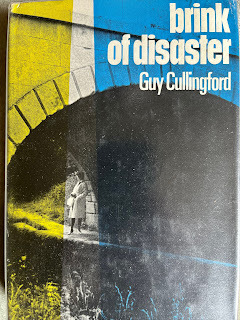
Brink of Disaster is another of Guy Cullingford's stand-alone novels about crime. The book was published in 1964 and has seldom been discussed in the past sixty years. The above cover image of the first edition jacket is of my copy, since there are none on the internet. You might say that it's a low-key book, and it's certainly unsensational, even though it features two murders and the threat of a third. The urban setting is rather bleak and the detective work of the official police less than stellar. None of this sounds like much of a recommendation, but I must say that I found the story extremely readable and I was gripped from start to finish.
The strength of the book lies in the unpredictability of the storyline, coupled with the author's ability to create characters who are interesting even if unlikeable. There's no mystery about the first murder. A man called Robert Cave kills a girlfriend on the spur of the moment. She finishes up in the bottom of the canal, but with the reluctant assistance of some family members, he is able to give the police an alibi, and they aren't able to pin the crime on him. But they are deeply suspicious and it's common knowledge that he's the prime suspect.
A newcomer to the town called Forbes decides to turn Cave's predicament to his advantage by framing him for the murder of his (Forbes') cousin Lucy. This struck me as an intriguing set-up for a novel and Guy Cullingford (whose real name was Constance Taylor) develops it in a very pleasing way. You never quite know what is going to happen next.
Constance Taylor was a member of the Detection Club (my copy is inscribed to her fellow member Michael Underwood, who was clearly a good friend) and her books received positive reviews, but even in her lifetime she was never very well-known. I think this is because she didn't write a series and each book she wrote seems to have been quite distinctive. That isn't really the way to achieve fame and fortune as a crime writer, but she has left a legacy of fascinating and unorthodox stories. I'm now very keen to read the rest of her books.
July 31, 2024
The Leading Man - 1997 film review

The Leading Man is a fairly obscure film from the late 90s that benefits from a very good cast and an unusual screenplay by Victoria Duigan, sister of the director John Duigan. It's set in the world of the theatre, with a charismatic and egotistical American actor called Robin Grange (played by Jon Bon Jovi, who is pretty good in the part) cast as leading man. The play is written by Felix Webb (Lambert Wilson) who is having an affair with young Hilary Rule (Thandiwe Newton), whom he manages to get cast in a key part.
Felix's wife Elena (Anna Galiena) is aware of the relationship - which certainly isn't as well-kept a secret as Felix believes - and at first it seems like her menacing response (she cuts Felix's hair while he is sleeping) is going to be the focus of the plot. But things take a different turn when Robin offers to do Felix a favour by seducing Elena. One oddity of the storyline is the way that Elena's personality seems to chance once Robin takes an interest in her. I'm not sure this is psychologically convincing, but who knows?
Some of the pleasure of the film comes from the performances of the actors in the play. They include such stalwarts as David Warner, Harriet Walter, Patricia Hodge, and Diana Quick. There's even a blink-and-you-miss-it cameo from Nicole Kidman. I was intrigued by the set-up of the story and couldn't guess how the tangle of relationships would work out - though it was pretty clear that a gun, featured as prominently as Chekhov's, would be relevant to what happened.
Unfortunately, the climax of the film is its weakest part. Possibly Victoria Duigan herself couldn't quite decide how to end the story. The finale that she chose has a low-key irony, but I felt it was a little disappointing. Overall, however, there are enough good moments and enough good actors in this film to make it worth watching.
July 29, 2024
Never Say Never Again - 1983 film review
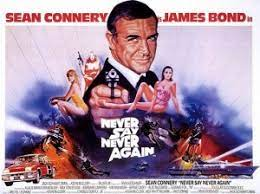
Over the years I've avoided Never Say Never Again, mainly because some people have said it's the worst James Bond movie. However, one evening when I felt in need of some fairly mindless entertainment, I decided to watch it. At the risk of damning with faint praise, I certainly don't think it is the worst Bond film. It's not bad. The real problem is that it doesn't make the best use of some excellent ingredients.
The story of how the film came into being is more interesting than the actual storyline (the same is true of the spoof version of Casino Royale in 1967). It was an outgrowth of the long-running litigation involving a hard-nosed guy called Kevin McClory and Ian Fleming and Eon Productions. McClory was a minor figure in the film world when he met Fleming. A writer called Jack Whittingham wrote a James Bond film script with some input from McClory but it got nowhere. Fleming used this material for his novel Thunderball, a foolish plagiarism that McClory exploited to lucrative effect for the rest of his life. There's a less than flattering obituary here.
Following his court success, McClory was entitled to reuse material from the novel of Thunderball (but not the film version) and became executive producer of Never Say Never Again, which competed with the 'official' Bond movie of the time, Octopussy. There was enough money sloshing around to lure Sean Connery back to resume his most famous role and to hire Lorenzo Semple Jr (whose CV included The Parallax View and Three Days of the Condor, two excellent films) to write the script. But the director, Irvin Kershner, wasn't happy, and he hired the British comedy writers Dick Clement and Ian La Frenais to work on the script (they weren't credited, possibly a good choice on their part). John Barry declined to write the music, so Michel Legrand - another film composer of the highest class - was brought in, and the theme song was performed by Lani Hall.
The result was an uneasy compromise. There are some good ideas in the storyline, as Semple sought to make a virtue out of necessity - i.e., the fact that Connery was an older man - but some of the attempts at humour introduced in the rewrite were thin. A young Rowan Atkinson has a disappointingly feeble cameo role, and Edward Fox, another actor I like, struggles with the role of M, who is written as a buffoon. Clement and La Frenais have done some fine work over the years, but their contribution to this film seems more reminiscent of their 1985 movie Water, which...well, didn't deserve to make a splash.
There are some good action scenes, although some of the underwater action at the end is...well, underwhelming. I am a lifelong Michel Legrand fan, but his style was not suited to a Bond movie, and the song (which isn't bad, though not one of his best) is misplaced over an action scene at the start of the movie. However there are compensations. Kim Basinger and Prunella Gee are very glamorous 'Bond girls' and Klaus Maria Brandauer is okay, if not quite menacing enough, as the villainous Largo. Above all, Connery eases his way affably through the movie, making the best of it and reminding everyone that, when it comes to James Bond, arguably nobody does it better.
July 26, 2024
Forgotten Book - Advisory Service
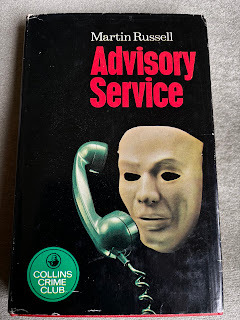
A hugely pleasurable dividend of posting on this blog is the fascinating correspondence I receive from readers. Recently I've been delighted to correspond with - and chat on the phone with - Betty Telford, who first got in touch with me some years ago, when commenting on a blog post about Martin Russell. Betty knew Martin, a fellow journalist, well, and I've learned more about him from her than from anyone. I am very grateful to all of you who comment and get in touch and I hope you will feel encouraged to continue to do so. Speaking to Betty has further increased my interest in Martin Russell's writing and I've just read one of his early novels of psychological suspense, Advisory Service, which dates from 1971.
Like a number of Russell's books, this one gains immediacy in part because the story is told in the first person and in part because he was good at writing snappy dialogue which moved the story along at a good pace. A middle-class couple, Eddie and Pearl Mills, who live in Hampstead with their nine year old daughter Lorna seem to have a very pleasant life. But beneath the surface, all is not well.
They receive some concerning anonymous telephone calls (the details of the landline calls are one of the things that differentiates this storyline from anything that could be written today, in the age of the smartphone). Then the pressure on them escalates as they receive anonymous letters from a so-called 'Advisory Service'. And then the unthinkable happens...
This is, as usual with Russell, a tense story and an easy, pacy read. I must say, however, that there were various elements of the story that tested my ability to suspend disbelief. To say more than that would be a spoiler, but (despite an unusual, cliff-hanger ending) I wasn't really convinced. Yet even though it's not one of his stronger books, in my opinion, I was still keen to keep turning the pages, and that was Martin Russell's great strength and the reason why he enjoyed quite a successful career for the best part of thirty years.
July 24, 2024
An E.C.R. Lorac Exhibition
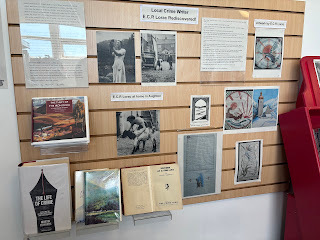
How times change. Not so long ago, the name of E.C.R. Lorac was little-known to crime readers. Almost all her seventy-odd novels had been out of print since the late 1950s, some of them long before that. And now she is the current best-selling writer among all those published in the British Library Crime Classics series. Quite a transformation. I'm sure my parents, who extolled the virtues of Lorac (especially Still Waters) to me when I was young - and at a time when her books were impossible to find - would be amazed and delighted.
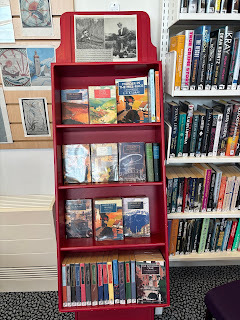
I was thrilled to be invited yesterday to, of all things, an E.C.R. Lorac exhibition at Halton Library in Lancashire. Halton isn't far from where Lorac (in real life, Carol Rivett) lived in Aughton (pronounced Afton) for the last decade and a half of her life. And Halton is now the home village of Lena Whiteley, who lived next door to the author when she was young. Her mother was Lorac's housekeeper and Lena helped in the house and garden from being very young.
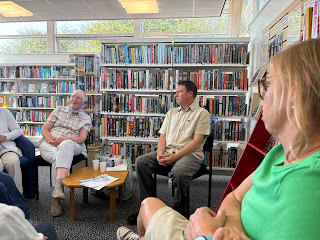
The exhibition, which has previously been on display at Bolton-le-Sands library, is splendid and includes several items that are in Lena's possession. She and her son David gave a talk about the author to an appreciative audience and mentioned that the fact that Lorac's Lunesdale books, which are among her very best, give such an evocative picture of the local area means that it's great fun to try to figure out the thinly disguised locations in the stories. A couple of years ago, Lena and David took me on a tour of the setting of Crook O'Lune, which was as interesting as it was helpful when I came to write the book.
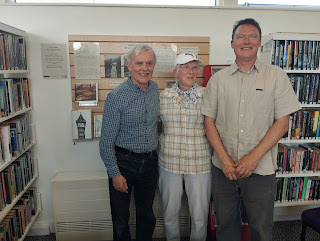
When I was in my twenties, I started picking up Lorac novels whenever I could find them in second hand shops and giving them to my parents, who devoured them. Now all those books are in my possession, but there are still quite a few of her novels (including many of the books she wrote as Carol Carnac) that I haven't read. Treats in store.
I mentioned Lorac briefly in my first Northern Blood anthology, more than thirty years ago, but it was only when I became involved with the Crime Classics that I was able to encourage the British Library to republish Lorac. It took years to trace the estate and copyright holders, but the work and the wait were worthwhile. Lorac (and Carnac) are being enjoyed all over again, by a new readership, and she's getting fantastic sales and reviews. In writing my intros, I've benefited enormously from my friendship with Lena, David and his sister Helen; the help they've given me has been invaluable.
And the good news is, there's another Lorac reissue on the way. Murder in Vienna is due out in November.
July 22, 2024
Musings on Noir Heroes; guest post from Luke Deckard
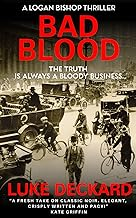
Luke Deckard is a thoughtful member of the new generation of crime writers, a generation which I'm keen to encourage whenever I can. So I was glad to include a short story of his in the forthcoming CWA anthology Midsummer Mysteries. His new novel Bad Blood, a Logan Bishop thriller, has just been published, and to celebrate this, I invited him to contribute a guest blog post. Here it is:
'In Plato’s The Republic, he writes, “Whenwe find out what justice is, we shall require the just man to answer thedescription precisely… or shall we be content if he approximates to it very closely…?”
My passion for writing and reading noir fictionis no secret. The emergence of the hard-boiled hero in 1920s America and itssubsequent evolution in the 30s/40s was a direct response to British crimefiction and a world steeped in disillusionment after the First World War. AsRaymond Chandler said in The Simple Art of Murder, the genre wanted toexplore realistic crime and a world where “gangsters can rule nations andalmost rule cities.”
But what is justice when the very system thatshould uphold it is corrupt? This is a question that many hard-boiled heroeshave grappled with, often choosing to leave the system they once served due toits inherent corruption.
Chandler added that, “Down these mean streets aman must go who is not himself mean, who is neither tarnished nor afraid.”Across the genre, its heroes, from Marlowe to Spenser, Millhone to Rebus andBosch et al., operate more as dark knights. A white knight can’t exist in theworld of Noir. However, I say these heroes are the answer to Plato’s musing;They might not be able to “answer the description precisely”, but they“approximate to it very closely.”
This is one of the many aspects I love aboutnoir fiction and why I love writing it. When I approached my novel BadBlood, I kept asking myself: What does it mean to be good in a bent world?How can one be hopeful in a wasteland? And I let my protagonist try to find hisway to those answers.
Crime fiction, generally, grapples with anunjust world, but noir fiction knows there is no cure. Crime isn’t a virus thatcan be eradicated, and surviving in that reality is no easy business! As PhilipMarlowe says toward the end of The Big Sleep, “Me, I was part of the nastinessnow.”
July 19, 2024
Forgotten Book - The Double Turn

Whether writing as E.C.R. Lorac or Carol Carnac (or as Mary Le Bourne in the case of her posthumously published Two-Way Murder), Carol Rivett kept up an impressive standard of crime writing to the end of her life. Someone who writes so prolifically for so long is bound to have the occasional misfire, but several of her very best books were written during the 1950s, and although some are (at least now) fairly well-known, others remain obscure.
What is more, her powers of invention do not seem to me to have diminished over the years. A little-known example of her qualities as a writer is Double Turn, a novel published under the name Carol Carnac in 1956, just two years before her death and known in the US as The Late Miss Trimming. This is another case for the likeable Chief Inspector Rivers and I found it very enjoyable.
The starting point for the story is - as in several of her books - the world of art. The opening chapter is set at an exhibition sponsored by the Central Arts Committee 'in aid of aged and indigent painters' and it introduces us to several key characters, including the lovely artist Susan Truby, her uncle Jocelyn, and two young men who admire Susan; we also get to hear about Adrian Delafield, a veteran artist whom Jocelyn knew but whose work has now gone out of fashion. Adrian is now looked after by a formidable but highly eccentric old woman called Trimming, while his daughter Virgilia lives in a studio adjoining her home.
Before long, we're confronted with an unexpected death, and it seems to be an accident. Rather surprisingly, I thought, given the slender evidence to the contrary, the police deem the death to be suspicious and Rivers is called in. There's an 'impossible crime' element to this story, but Lorac was no John Dickson Carr; her focus is on character and the book is none the worse for that. A strange misprint (I think it must be a misprint) in my copy seemed to give a strong hint to the solution to the puzzle, something I've not encountered previously. But overall this is a example of Lorac/Carnac in very good form.
July 17, 2024
Gwen Moffat - 100 Years Young

I was tipped off recently by my crime fiction loving friends Nigel Moss and Barry Pike that fellow northern crime writer Gwen Moffat was celebrating a very special birthday. Believe it or not, Gwen was 100 on July 3. I was away on holiday at the time but managed to send her a slightly belated congratulatory message - and received a very prompt and positive reply from the lady herself.
Gwen's greatest claim to fame is no doubt her pioneering work as a woman mountaineer and in 1961 she published a very well-received autobiography, The Space Beneath My Feet. She was also the first British female mountain guide. A few years ago, a film documentary which is well worth a watch supplied a fascinating picture of how Gwen's indomitable style had influenced and inspired younger women climbers.
In the 1970s she turned to writing crime fiction, and created a series character called Miss Pink who was - naturally! - a keen climber. I got to know her in the 1990s, when she came along to CWA northern chapter get-togethers. From the outset, she struck me as a formidable character - as you need to be, to do the things that Gwen has done in her life.
We met on many occasions over the years, but I haven't seen her in person for quite a while, so I was particularly pleased to hear from her again. Congratulations, Gwen, and many happy returns!



